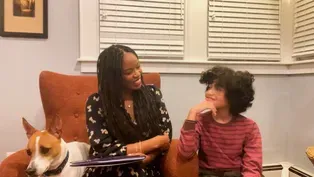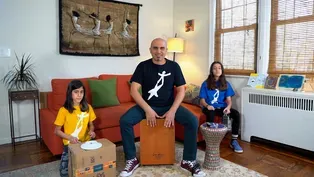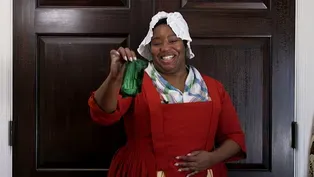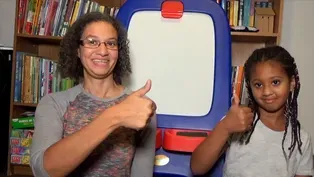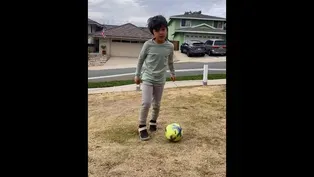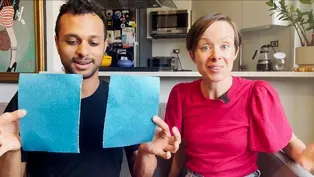
Animals are Similar
Clip: 4/3/2023 | 8m 5sVideo has Audio Description, Closed Captions
Travis Cherry shows how the animals at the Memphis Zoo are similar to humans.
Meet animals at the Memphis Zoo with Travis Cherry. Birds, reptiles, and mammals are similar to each other and to humans in many ways. Like us, they play, show emotions, and have their own families. Learn how we can help animals in the wild.
See all videos with Audio DescriptionADProblems with Closed Captions? Closed Captioning Feedback
Problems with Closed Captions? Closed Captioning Feedback
Let's Learn is a local public television program presented by THIRTEEN PBS

Animals are Similar
Clip: 4/3/2023 | 8m 5sVideo has Audio Description, Closed Captions
Meet animals at the Memphis Zoo with Travis Cherry. Birds, reptiles, and mammals are similar to each other and to humans in many ways. Like us, they play, show emotions, and have their own families. Learn how we can help animals in the wild.
See all videos with Audio DescriptionADProblems with Closed Captions? Closed Captioning Feedback
How to Watch Let's Learn
Let's Learn is available to stream on pbs.org and the free PBS App, available on iPhone, Apple TV, Android TV, Android smartphones, Amazon Fire TV, Amazon Fire Tablet, Roku, Samsung Smart TV, and Vizio.
Providing Support for PBS.org
Learn Moreabout PBS online sponsorship[bright music] - Hi friends.
My name is Travis.
I'm an animal interpreter here at the Memphis Zoo in Memphis, Tennessee.
Did you know that everything, from a fish to a bird to a snake, a lizard, even spiders and scorpions are all considered animals?
Everything, from the smallest ant to the biggest blue whale are all animals like us.
There are a few very simple things that we all share with these wonderful creatures, like how we can feel emotions like happiness, being sad, or sometimes angry.
They grow up too and get big and strong to thrive in their wild homes.
And some have families and personalities that are both similar and different from our own.
So come with me and some of my animal friends here in the zoo we'll show you that we're really not so different after all.
There are thousands of different kinds of birds, everything from tiny sparrows to big hawks, like the red-tailed hawk.
And just like how I'm using my voice to talk to all of y'all, birds use their voices too to talk to other birds.
But theirs sounds a bit different.
They do calls or even sing songs to each other.
They also use their bodies to speak to each other as well.
Just like us, birds feel things.
And while they might not be telling everyone how they feel using their voice, they can do so using their bodies.
Some birds feel dirty.
They take baths in puddles of water or bird baths in our gardens.
Some birds get scared of other animals, so they'll call for their friends to warm them of any potential dangers in the area.
And some birds can get really sleepy.
They'll fluff their feathers up, bury their heads in their bodies, and go to sleep where they feel safe and comfortable.
When I was a kid, I really loved playing with toys and making up stories.
Valentine the turkey vulture isn't telling stories with her toys but she is still playing with them and using her mind.
She loves pulling at things, using her strong beak to tear at boxes.
In the wild, she'll be using those same strategies to get to any tasty snacks that might be a bit hidden.
Some birds, like crows and ravens, have even been seen to surf on the air by holding a leaf or a twig in her feet.
When our friends or family get sick, we try our best to help them feel better.
Parrot hawks will do the same thing.
If a member of their flock gets hurt, they'll bring them food so they can rest.
Now that we've seen how birds feel emotions, they'll play around, or even help each other out, we can better connect with our feathery friends.
So the next time you see one out in the world, imagine if you were one too.
This is Bisquick.
He's a pancake tortoise.
And like other turtles, snakes and lizards, he's a reptile.
And while reptiles are covered in scales instead of hair like we are, we can look at reptiles and see that we have a lot in common.
Some reptiles love to explore.
Some tortoises are always on the move, looking for food, making sure their homes are safe.
Some reptiles, like a lot of snakes, don't like to explore as much.
They like to bask in the sunlight and take long naps until they get hungry and hope food comes to them.
Crocodiles, some lizards, and many other reptiles are amazing parents.
Crocodile moms protect their nests, sometimes not even moving until they hatch.
And when they do, she'll carry them on her back until their big and strong enough to survive on their own.
Isn't it interesting though, while your family might be different than a crocodile, but we both have caregivers help us live and grow.
We are very lucky here at the zoo because we get to work with Monty, the Ball python.
Monty here is 38-years-old, which is pretty old for a snake.
Monty also only has one eye.
But Ball pythons have a special skill where they can see how hot their prey is.
They also have a forked tongue they could use to sniff out where their smelly prey might be.
So while Monty here might look a bit different than other Ball pythons, she is just as capable as any other snake.
As we saw, reptiles can show emotions, just like us and our bird friends, and they can have amazing families too.
And while there are many different kinds of birds and reptiles that come in all shapes, colors, and sizes, all of these wonderful animals are enjoying the world we live in, just like us.
Mammals are animals that are covered in fur and sometimes hair.
And did you know that humans are mammals too?
We're actually distant relatives of primates, like gorillas and chimps.
And you're probably more used to seeing cats and dogs, but all mammals can be just like us, having fun, having feelings, and having their own special families and lives.
Picture a dog playing with a ball or a cat stretching in a sunbeam.
The dog is probably happy and playful.
The cat is probably sleepy.
And just like you and I can get nervous or scared sometimes, mammals can too.
Porcupines will raise their quills up and show up how big and pointy they are when they get nervous.
And some mammals, like rats and other rodents, live in large families.
While some others like opossums, bears, and wild cats likely more by themselves.
We saw earlier how birds, like crows and vultures, play.
And other animals, like mammals, love to play too.
Big cats, like lions, when they're young will playfully pounce on each other and play fight.
This helps 'em gain the skills they need to survive in the wild.
As they get older, some mammals prefer to nap instead of playing and that's fine too.
There are thousands of different kinds of mammals in the world and there are hundreds of different families they can have.
Some live in large groups called colonies, like these meerkats, where they help each other.
Some live with just a friend or even a relative.
And some animals prefer to live by themselves.
No matter how large their families are, mammals are amazing animals, and helping each other out doesn't stop at just friends they know.
Beavers are famous for their homes called lodges and their dams.
And when it gets cold, you can find them housing other animals, like frogs and chipmunks, in their lodges too.
This is my favorite animal in the entire world.
This is the Virginia opossum and they can sometimes have a huge family.
Sometimes mom can have 13 kids.
But once they all grow up, they tend to go their separate ways.
They might spend the rest of their lives by themselves.
They're a perfect example that no matter where you come from, you can live life in your own unique way.
Just like humans have so much diversity, but we're also humans, mammals are the same way.
Just think about how many different types of dogs there are, but they're all still dogs.
And there are animals that will change their color with the changing seasons, but sometimes the same animal can change its entire look.
But no matter what they look like, they're still the same wonderful animal.
We learned a lot about our mammal friends here today.
We learned that there are thousands of different kinds of mammals with hundreds of different kinds of families.
They can all show emotions, they can have friends and family, and they all like to play around and do things like you and I like to do.
So sometimes it's cool to think that we share something in common with our furry, four-legged friends like Opal here.
Now that we've seen some of the amazing animals here at the zoo, we could see that we're not so different after all.
I mean not just mammals, we talked about, we saw reptiles and birds too.
Everything from the smallest ant to the biggest blue whale, we all share something with.
And just like these animals help each other in the wild, there are a few simple things we can do to help them just by putting our trash in the right places or just leaving wild animals be.
Or always we can make sure that these wonderful creatures can share all the joy this world can bring.
So I wanna thank you for joining me on this journey.
I hope you had fun today, I know I did.
Video has Audio Description, Closed Captions
Clip: 4/3/2023 | 7m 38s | Maria Begg-Roberson reads Brave Miss Muffet by Dori Graham and illustrator Kyle Beckett. (7m 38s)
Create Beats with Percussion Instruments
Video has Audio Description, Closed Captions
Clip: 4/3/2023 | 10m 51s | Yakir Ben-Hur, National Dance Institute, creates beats with a variety of instruments. (10m 51s)
Objects and Money from Long Ago
Video has Audio Description, Closed Captions
Clip: 4/3/2023 | 9m 43s | Cheyney McKnight from New-York Historical Society shows objects and money from long ago. (9m 43s)
Video has Audio Description, Closed Captions
Clip: 4/3/2023 | 9m 56s | Anna Scretching-Cole helps children learn about the short a vowel sound. (9m 56s)
Video has Audio Description, Closed Captions
Clip: 4/3/2023 | 48s | Tomio shows children soccer moves. (48s)
Video has Audio Description, Closed Captions
Clip: 4/3/2023 | 7m 42s | Omar Etman and Lily Fincher play math games and show children the importance of fair play. (7m 42s)
Providing Support for PBS.org
Learn Moreabout PBS online sponsorshipSupport for PBS provided by:
Let's Learn is a local public television program presented by THIRTEEN PBS
